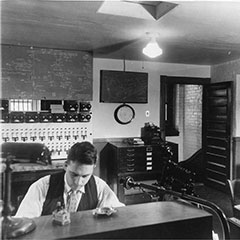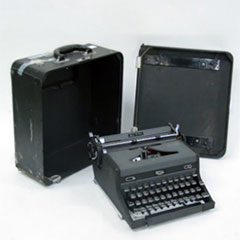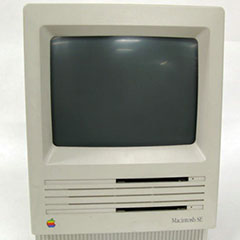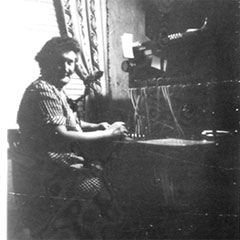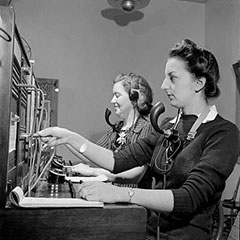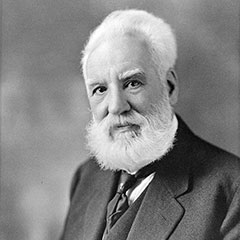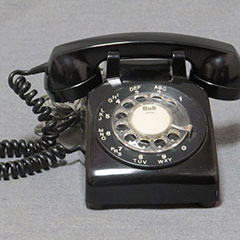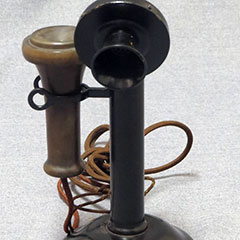Technology in the Workplace
The spectacular growth of the Canadian industry, in extent as well as in importance, at the end of the 19th and the beginning of the 20th centuries required an unprecedented level of coordination of economic activities throughout the country. Administrative procedures, planning and analysis became essential aspects of business management. The modern office, peopled with administrators and clerks who coordinate and record the business’ production activities, emerged at this time.
To make work simpler, offices were equipped with new machines and cutting-edge technology: calculators, addressing machines, and typewriters are among the many icons of office paraphernalia.
Invented during the 19th century by the Remington Company in the United States, the typewriter was perfected the following century. The very first typewriters did not allow the typist to see the words she was typing. It was not until 1893 that the Underwood Company invented the first machine with visible text. The electrical typewriter made its appearance after 1920.
In the 1980s, technological improvements brought further changes to secretarial and office work with word processing, intercoms, smart copiers, microcomputers, and email.
Office noises
Download audio (35 seconds, 1.37 MB)
Evolution of sounds related to work in an office, from the scratching of a pencil on paper to the sound of a printer, including a typewriter and a computer keyboard and mouse.
Author: Pierre Brouillette Hamelin
Hello?
Since the end 19th century, the telephone has played an essential role in the transmission of human voices over a great distance. While it was originally dependent upon phone operators, Canada’s phone network began its automation in the 1950s. From then on, microwave antennas and underwater cables facilitated overseas and long-distance calls. Soon, chip cards and satellites transformed telephony in our nation.
A History of Telephones in Canada
On March 10th 1876, in Boston, Massachusetts, Alexander Graham Bell’s prototype – called a ‘vibraphone’ – managed for the first time to transmit its inventor’s voice over a distance. With a few associates, he founded the Bell Telephone Company and marketed the first phones. Since 1877, this device has been part of Canadian lives.
Originally seen as a scientific oddity, and then as a communication device for business purposes, the telephone gradually entered homes at the turn of the 20th century. Because of the high rates associated with its use, nearly $150 for the installation of a telephone line, it was reserved for the wealthy for a long time, but eventually reached the middle-classes in the 1950s.
In rural areas, the implementation of the telephone was slower, and it was not uncommon that many people came together to use the very same phone line (party lines). This option was offered by several telephone companies to reduce installation costs. However, you would have to be careful when having confidential conversations as the village gossips would have the wicked pleasure of listening to the conversations of others! In 1956, almost 40% of Québec and Canada still had shared phone lines.
Many businessmen relied on it to work from home. Similarly, the doctor often installed the first telephone line in the village to connect his office to the pharmacy and his various patients. For the homemaker, the telephone became a tool for domestic management. It also became a powerful vehicle for socializing.
Until the 1920s, before the rotary dial telephone set was invented, the Operator was essential to communications. A telephone operator’s job was very demanding. She needed to display a rock solid concentration and great manners, all the while wearing a heavy headset. She carried out tedious actions and repeated the same phrases over and over during a fast paced workday, especially during peak hours.
In July 1964, the Touch-ToneTM service was launched. When pushbuttons replaced dials, and electrical switch technology was introduced in 1967, telephone sets became data terminals.
Mobile Telephony
During the second half of the 20th century, wireless telephony transformed communication habits by giving its users mobility. In 1947, Bell Canada offered mobile radio-telephone service in Montréal and Toronto. This technology was limited to emergency services and to a few professional groups, such as salespeople and journalists. Launched in Canada in 1962, the Bellboy pager system made wireless terminals accessible to the general public. In July 1985, Bell Canada inaugurated its cellular telephone service.
In this era of personal communications, phones are no longer associated with places, but with people. Many products stemming from the telephone industry belong to mobile communication technologies: radiophones, pagers, cell phones, personal communications services (PCS), notebook computers, etc. Nowadays, with Internet and other mobile systems being inter-connected, computers have become mobile devices granting entry to numerous databases. Wires are no longer needed to access human voice, music, documents, photos or videos.The Phone’s Ringtone
The phone’s ringtone informs a person of an incoming call. Originally, two basic types of bells were included in telephone sets. In the first, a metal hammer hit a bell, while in the second, a metal plate vibrated when receiving a call. When electronic telephone sets appeared in the 1960s, these piercing mechanical ringtones were replaced by more melodious sounds.
A significant evolution was brought on by portable phones. For a long time, these devices only produced strident beeps, but technological progress allowed for more sophisticated ringtones. The simple beeps were replaced by two or four-toned melodies. Nowadays, digital ringtones allow an array of possibilities, from more classical options to current musical hits.
Phone rings
Download audio (31 seconds, 1.20 MB)
Evolution of the different sounds related to the phone, such as the sound of dialing up with a rotary phone, a tone, phone ringtones, cell phone ringtones and finally the sound of a phone that is being hung up.
Author: Pierre Brouillette Hamelin

